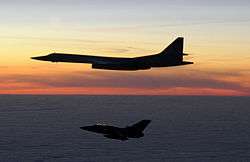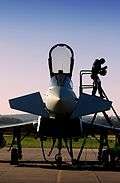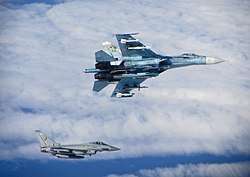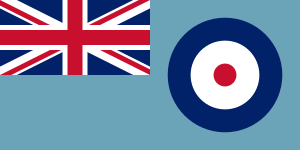Quick Reaction Alert
Quick Reaction Alert (QRA) is state of readiness and modus operandi of air defence maintained at all hours of the day by NATO air forces.
Some non-NATO countries also maintain QRA, although not necessarily full-time. These include Switzerland and Austria.[1][2]

Operation
QRA in the United Kingdom
Pilots and engineers on QRA duty are at immediate readiness twenty-four hours a day fully dressed in the Crew Ready Room, which are next to the hangars (a hardened aircraft shelter known informally as Q-sheds) which houses the interceptor aircraft, since 2007 the Eurofighter Typhoon. Pilots are on QRA duty around once or twice a month, each a twenty-four-hour shift. Engineers are on QRA duty three or four times a year, each for a twenty-four-hour a day shift for seven days at a time. Two Typhoon aircraft are on duty, each with two 2,000 litre drop tanks, four Advanced Short Range Air-to-Air Missiles (ASRAAM), and four AIM-120 Advanced Medium Range Air-to-Air Missiles. It will soon carry the Meteor missile. A Voyager tanker is also always ready, with aircrew available 24hrs a day, at RAF Brize Norton in Oxfordshire; before 2014 this was carried out by a TriStar.

Civilian aircraft in the UK are monitored by NATS Holdings at:
- Swanwick, Hampshire with the London Area Control Centre and London Terminal Control Centre (at RAF West Drayton until 2007), broadly known as the London Air Traffic Control Centre, which covers the London Flight Information Region (EGTT). The RAF have a team at Swanwick.
- Prestwick, which covers the Scotland Flight Information Region (EGPX) which is north of the Solway Firth.

Military radar in the UK is controlled by the UK Air Surveillance and Control System (ASACS),[3] looked after by ASACS Force Command.[4] It has Remote Radar Heads (RRH) at:
- RRH Benbecula in the Outer Hebrides
- RRH Saxa Vord in the Shetland Isles (AN/TPS-77 radar moved fom RRH Staxton Wold)
- RRH Buchan (former Master Radar Station, or MRS, Buchan) off the A90 south of Peterhead
- RRH Brizlee Wood in Denwick, Northumberland (west of RAF Boulmer) three miles directly west of Alnwick in Hulne Park
- RRH Staxton Wold off the B1249 in Willerby in the east of North Yorkshire; the Yorkshire Wolds Way passes next to it.
- RRH Neatishead at Trimingham on the Norfolk coast
- RRH Portreath in Cornwall
The radars were Type 93, and are being replaced by the Lockheed Martin AN/FPS-117 system.
QRA response
Air traffic across Europe is controlled by Eurocontrol in Brussels. Military aircraft from Russia can be tracked across Norway, and reported to the Norwegian Joint Headquarters near Bodø, or the Combined Air Operations Centre 2 (CAOC UE) in Uedem, North Rhine-Westphalia close to the border with The Netherlands. Combined Air Operations Centre Finderup (CAOC Finderup),[5] in Denmark, watches Russian aircraft and can alert the UK, and has RAF staff there. The Russian Tu-95 Bear aircraft originate from the Olenya base on the Kola Peninsula and the Tu-160 Blackjack aircraft come from the Engels-2 base near Saratov. The Bear aircraft are on 12-14 hour missions, and when tracked across Norway have been colloquially referred to with the codename of zombies.
A QRA response involves the fighter aircraft being scrambled to investigate an infringement of the NATO country's airspace or area of interest.
QRA response in the United Kingdom
This may also be a civilian aircraft that poses a threat, if not sufficiently responding to air traffic control (ATC); incidents of this nature in the UK are monitored by the Control and Reporting Centres (CRC) at RAF Boulmer and RAF Scampton, which builds a 3D Recognised Air Picture and the National Air Defence Operations Centre (NADOC) RAF Air Command, if notified, decides whether to send a QRA response. Joint Force Air Component Headquarters is also at High Wycombe.

QRA stations
QRA RAF stations
Currently there are two QRA RAF stations, of 1 Group.
- RAF Coningsby in Lincolnshire looks after the southern sector of the UK, known as QRA South, with 3 and 11 (XI) squadrons.
- RAF Lossiemouth in Moray protects the northern sector of the UK, referred to as QRA North,[6] hosted by 1 Sqn, No. 2 Squadron RAF and 6 Sqn.
Bulgaria
Graf Ignatievo Air Base (3rd Fighter Air Base) of the BuAF has a single MiG-29 squadron, which carry two R-73 missiles. the Bulgarian CRC is at Sofia.
Italy
At Grosseto Air Base, in the Province of Grosseto on the west Italian coast, the Typhoon is operated by 4º Stormo of IX Gruppo, 36º Stormo of 12 Gruppo, and 10 Gruppo. Aeroporto di Trapani-Birgi has the 37th Fighter Wing. At Amendola Air Base F-35 is operated by 32° Stormo of 13° Gruppo
Netherlands
The Royal Netherlands Air Force have F-16 aircraft at Volkel Air Base or Leeuwarden Air Base on high alert. They intercept once notified by the Air Operations Control Station Nieuw-Milligen, near Apeldoorn in Gelderland. The Royal Netherlands Air Force shares the responsibilities for QRA above Benelux with the Belgian Air Component since 2016/2017.
Romania
The RoAF 71st Air Base (Baza 71 Aeriană) at Câmpia Turzii in central Romania and the RoAF 86th Air Base (Baza 86 Aeriană) at Borcea in south-east Romania both operate the MiG-21 LanceRs, which carry the Matra Magic 2 missile. The Romanian CRC is at Balotești in southern Romania.
Spain
At the Morón Air Base at Morón de la Frontera in the Province of Seville in the south of Spain, Ala 11 (11th Wing) has three squadrons of Typhoons, with 111 Sqn and 112 Sqn. Los Llanos Air Base has 141 Sqn and 142 Sqn of Ala 14.
Turkey
Merzifon Air Base of the TuAF (Türk Hava Kuvvetleri), in northern Turkey, has two F-16 squadrons (built by TAI) with the 5th Air Wing (5 Ana Jet Üs). Bandırma Air Base has two F-16 squadrons of the 6th Air Wing. The Turkish CRC is at Ahlatlabel near Ankara.
History
Quick Reaction Alert is the current development from scrambling by RAF Fighter Command in the Battle of Britain.
Germany
RAF Wildenrath provided air defence cover for Royal Air Force Germany (RAFG), which flew Phantoms with 92 Sqn and 19 Sqn until 1991. On 25 May 1982, RAF Phantom XV422 of 92 Sqn shot down RAF Jaguar XX963 of 14 Sqn from RAF Bruggen with a Sidewinder, over Germany, by mistake when the Phantom pilot did not realise that he was fully armed.
Italy
The first country to put the Typhoon onto QRA duty was Italy on 16 December 2005, by 4º Stormo of IX Gruppo; 36º Stormo followed on 1 July 2007 and 10 Gruppo on 1 July 2010. Typhoons replace the F-16 at Trapani from May 2012. From 1 March 2018 the F-35 of 32°wing based in Amendola has implemented the QRA assets.
Spain
111 Sqn put the first Typhoon on QRA duty in July 2008, followed by 142 Sqn of Ala 14, and later 141 Sqn.
United Kingdom



In the 1950s and 1960s, training as a fighter controller in the UK was at MRS Bawdsey (RAF Bawdsey); the main central control was known as ADOC (similar to the USA's and Canada's NORAD at Peterson Air Force Base) which monitored the UK Air Defence Region (UK ADR). The ROTOR system was developed in the 1950s. Before computers arrived in the 1970s, the Russian aircraft were plotted on a map, mainly by WRAF personnel. 11 Group (at RAF Bentley Priory from 1968 and RAF High Wycombe from 1972) looked after the UK's air defence until the 1990s; High Wycombe today has the European Air Group.
Every QRA alert required a Victor tanker from RAF Marham in Norfolk, which the codename Dragonfly. One fighter squadron would be on QRA for six month shifts. The Phantom had much better range than the Lightning, and had far-better look down radar, but the Lightning had better performance. The RAF Phantom variant had Spey engines, which were not intentionally designed for the aircraft, and gave lower performance; it had an advanced jam-resistant inertial navigation system but the RAF Phantoms could not take off immediately as this inertial system had to align first. The Lightning left service in 1988 and the Phantom in 1992. Only when the Tornado F.3 arrived did RAF QRA duty have an aircraft that had complete night-vision capabilities and could connect to the Sentry aircraft.
In the 1960s, Southern Q was at maintained by the Lightnings of 5 Sqn at RAF Binbrook and those of 29 Sqn and 111 Squadron at RAF Wattisham. Southern Q was rotated around the three RAF bases. RAF Leeming took over Southern Q from RAF Coningsby in 1988. 11 Sqn left RAF Leeming in October 2005,[7] then on 29 June 2007, 3 Sqn at RAF Coningsby took over Southern Q from the Tornados of 25 Sqn at RAF Leeming in North Yorkshire, with the Typhoons of 3 Sqn having their first scramble on 17 August 2007 when they intercepted a Russian Bear; 3 Sqn took over all of Southern Q from 1 April 2008. In August 2007 the Russians had begun to launch long-distance patrols after a 15-year hiatus. Typhoons arrived at RAF Leuchars with 6 Sqn from 6 September 2010, performing their first QRA scramble on 2 January 2011, with Typhoons joining 1 Sqn from 15 September 2012. 6 Sqn moved to Lossiemouth in June 2014, with 1 Sqn moving in August 2014. QRA North was moved from RAF Leuchars to RAF Lossiemouth on 1 September 2014. The first QRA sortie from Lossiemouth was on 19 September 2014 with 6 Sqn.
2012 Olympics
To cover the security for the 2012 Summer Olympics, part of QRA South was briefly deployed from RAF Coningsby to operate from RAF Northolt.
See also
- ACCS
- Baltic Air Policing
- Cold War II
- NATO Integrated Air Defense System (NADGE, or NATO Air Defence Ground Environment, in the 1950s)
- Category:Military radars of the United Kingdom
- Category:Telecommunications equipment of the Cold War
- Category:Soviet Long Range Aviation bases
References
- Fiona Lombardi; The Swiss Air Power: Wherefrom? Whereto?, vdf Hochschulverlag AG, 2007, Page 95.Swiss Air Power
- Georg Mader; "Austria further reduces QRA capabilities", Air Platforms, Jane's 360, IHS, 21 August 2014.
- ASACS
- ASACS Force Command
- Finderup history PDF
- QRA North September 2014
- Tornado F3 in Focus: A Navigator's Eye on Britain's Last Interceptor
External links
| Wikimedia Commons has media related to Quick Reaction Alert. |
- September 2012 MoD document
- "Quick Reaction Alert". RAF 2004 (PDF) (Report). Royal Air Force. 2004. pp. 38–43. Retrieved 3 August 2015.
